Database Normalization by Dr. Kamal Gulati
- 2. Dr. Kamal Gulati Database Normalization • The main goal of Database Normalization is to restructure the logical data model of a database to: – Eliminate Redundancy – Organize Data Efficiently – Reduce the potential for Data Anomalies.
- 3. Dr. Kamal Gulati Redundancy • Remove Unnecessary data, • Remove Duplicate data, • Remove surplus data and • Remove unneeded data
- 4. Dr. Kamal Gulati Duplication Vs Redundant Data • Duplicated Data: When an attribute has two or more identical values • Redundant Data: If you can delete data with a loss of information
- 5. Dr. Kamal Gulati Data Efficiently • Data should be Competently, • Data should be Resourcefully and • Data should be Satisfactory.
- 6. Dr. Kamal Gulati Data Anomalies • Data anomalies are inconsistencies in the data stored in a database as a result of an operation such as update, insertion, and/or deletion. • Such inconsistencies may arise when have a particular record stored in multiple locations and not all of the copies are updated. • We can prevent such anomalies by implementing 7 different level of normalization called Normal Forms (NF)
- 7. Dr. Kamal Gulati Different Type of Normalization • In database design, we start with one single table, with all possible columns. A lot of redundant data would be present since it’s a single table. • The process of removing the redundant data, by splitting up the table in a well defined fashion is called normalization.
- 8. Dr. Kamal Gulati Levels of Normalization • 1. First Normal Form (1NF) • 2. Second Normal Form (2NF) • 3. Third Normal Form (3NF) • 4. Boyce-Codd Normal Form (BCNF) • 5. Fourth Normal Form (4NF) • 6. Fifth Normal Form (5NF) • 7. Domain Key Normal Form (DKNF)
- 9. Dr. Kamal Gulati Most databases should be 3NF or BCNF in order to avoid the database anomalies.
- 10. Dr. Kamal Gulati Levels of Normalization Each higher level is a subset of the lower level DKNF 1NF 2NF 3NF 4NF 5NF
- 11. Dr. Kamal Gulati Brief History / Overview • Database Normalization was first proposed by Edgar F. Codd. • Codd defined the first three Normal Forms, which we’ll look into, of the 7 known Normal Forms. • In order to do normalization we must know what the requirements are for each of the three Normal Forms that we’ll go over. • One of the key requirements to remember is that Normal Forms are progressive. That is, in order to have 3rd NF we must have 2nd NF and in order to have 2nd NF we must have 1st NF.
- 12. Dr. Kamal Gulati First Normal Form (1NF)
- 13. Dr. Kamal Gulati 1. First Normal Form (1NF) •A table is in its first normal form if it contains no repeating attributes or groups of attributes
- 14. Non-Normalised Table Number Name Classes 001231 William Hartnell Information Systems, Systems Analysis, Data Communications 001232 Patrick Troughton Systems Analysis, Data Communications 001233 Jon Pertwee OO Programming, Systems Analysis, Data Communications 001234 Tom Baker Systems Analysis, Data Communications Dr. Kamal Gulati
- 15. Dr. Kamal Gulati First Normal Form • To convert data for unnormalised form to 1NF, simply convert any repeated attributes into part of the candidate key • STUDENT(Number, Name, Classes) • STUDENT(Number, Name, Classes)
- 16. First Normal Form Number Name Classes 001231 William Hartnell Information Systems 001231 William Hartnell Systems Analysis 001231 William Hartnell Data Communications 001232 Patrick Troughton Systems Analysis 001232 Patrick Troughton Data Communications 001233 Jon Pertwee OO Programming 001233 Jon Pertwee Systems Analysis 001233 Jon Pertwee Data Communications 001234 Tom Baker Systems Analysis 001234 Tom Baker Data Communications Dr. Kamal Gulati
- 17. Dr. Kamal Gulati 1. First Normal Form (1NF) • The requirements to satisfy the 1st NF: – Each table has a primary key: minimal set of attributes which can uniquely identify a record – The values in each column of a table are atomic (No multi- value attributes allowed). – There are no repeating groups: two columns do not store similar information in the same table. • A relation is said to be in first normal form if and only if all underlying domains contain atomic values only. • After 1NF, we can still have redundant data.
- 18. Over to you... RefNo Name Address Status AccNo 345 C.J. Date 23, High Street Business 120768, 348973 543 F.D. Rolland 45, The Ash Domestic 987654 675 D.R. Howe 17, Low Street Business 745363, 678453, 348973 Dr. Kamal Gulati
- 19. Table in 1NF RefNo Name Address Status AccNo 345 C.J. Date 23, High Street Business 120768 345 C.J. Date 23, High Street Business 348973 543 F.D. Rolland 45, The Ash Domestic 987654 675 D.R. Howe 17, Low Street Business 745363 675 D.R. Howe 17, Low Street Business 678453 675 D.R. Howe 17, Low Street Business 348973 Dr. Kamal Gulati
- 20. Dr. Kamal Gulati Second Normal Form (2NF)
- 21. Dr. Kamal Gulati 2NF A table is in the second normal form if it's in the first normal form AND no column that is not part of the primary key is dependant only a portion of the primary key.
- 22. Dr. Kamal Gulati Functional Dependency • The concept of functional dependency in central to normalisation and, in particular, strongly related to 2NF.
- 23. Dr. Kamal Gulati Functional Dependency • If ‘X’ is a set of attributes within a relation, then we say ‘A’ (an attribute or set of attributes), is functionally dependant on X, if and only if, for every combination of X, there is only one corresponding value of A • We write this as : X -> A
- 24. Table in 1NF RefNo Name Address Status AccNo 345 C.J. Date 23, High Street Business 120768 345 C.J. Date 23, High Street Business 348973 543 F.D. Rolland 45, The Ash Domestic 987654 675 D.R. Howe 17, Low Street Business 745363 675 D.R. Howe 17, Low Street Business 678453 675 D.R. Howe 17, Low Street Business 348973
- 25. Dr. Kamal Gulati Functional Dependency • It is clear that : RefNo -> Name, Address, Status or, most correctly, AccNo, RefNo -> Name, Address, Status
- 26. Second Normal Form RefNo AccNo 345 120768 345 348973 543 987654 675 745363 675 678453 675 348973 RefNo Name Address Status 345 C.J. Date 23, High Street Business 543 F.D. Rolland 45, The Ash Domestic 675 D.R. Howe 17, Low Street Business Dr. Kamal Gulati
- 27. Dr. Kamal Gulati 2. Second Normal Form (2NF) – All requirements for 1st NF must be met. – Redundant data across multiple rows of a table must be moved to a separate table. • The resulting tables must be related to each other by use of foreign key. • A relation is said to be in 2NF if and only if it is in 1NF and every non key attribute is fully dependent on the primary key. • After 2NF, we can still have redundant data.
- 28. Over to you... Supplier# Part# City Quantity S1 P1 London 1000 S1 P2 London 1500 S1 P3 London 3400 S1 P4 London 2100 S2 P2 Paris 3400 S2 P3 Paris 1000 S4 P1 Nuku alofa 5 S4 P4 Nuku alofa 7 Dr. Kamal Gulati
- 29. Table in Second Normal Form Supplier# City S1 London S2 Paris S4 Nuku alofa Supplier# Part# Quantity S1 P1 1000 S1 P2 1500 S1 P3 3400 S1 P4 2100 S2 P2 3400 S2 P3 1000 S4 P1 5 S4 P4 7 Dr. Kamal Gulati
- 30. Third Normal Form (3NF) Dr. Kamal Gulati
- 31. A table is in the third normal form if it is the second normal form and there are no non-key columns dependant on other non-key columns that could not act as the primary key. Dr. Kamal Gulati
- 32. Table in Second Normal Form Branch Name Address Manager No Acc No Balance Type Rathmines 15 Upr Rathmimes Road 1234 1205 -£123.45 ‘D’ Rathmines 15 Upr Rathmimes Road 1234 6784 £67.54 ‘C’ Rathmines 15 Upr Rathmimes Road 1234 9843 £43.43 ‘C’ Dame St. 1 Dame Street 1101 5422 £34.50 ‘C’ Dame St. 1 Dame Street 1101 0998 £666.66 ‘D’ Dr. Kamal Gulati
- 33. Table in Third Normal Form Branch Name Address Manager No Rathmines 15 Upr Rathmimes Road 1234 Dame St. 1 Dame Street 1101 Acc No Balance Type Branch Name 1205 -£123.45 ‘D’ Rathmines 6784 £67.54 ‘C’ Rathmines 9843 £43.43 ‘C’ Rathmines 5422 £34.50 ‘C’ Dame St. 0998 £666.66 ‘D’ Dame St. Dr. Kamal Gulati
- 34. Dr. Kamal Gulati 3. Third Normal Form (3NF) • The requirements to satisfy the 3rd NF: – All requirements for 2nd NF must be met. – Eliminate fields that do not depend on the primary key; • That is, any field that is dependent not only on the primary key but also on another field must be moved to another table. • A relation is said to be in 3NF, if and only if it is in 2NF and every non key attribute is non- transitively dependent on the primary key.
- 35. Dr. Kamal Gulati Boyce-Codd Normal Form (BCNF)
- 36. Dr. Kamal Gulati Boyce-Codd Normal Form • All attributes in a relation should be dependant upon the key, the whole key and nothing but the key
- 37. Table in Third Normal Form CourseNo Lecturer Time Room FT225/2 P. O’Byrne 9.00 121 FT222/1 D. Gordon 10.00 666 DT266/2 K. O’Brien 1.00 343 DT266/1 D. Carroll 11.00 876 FT222/4 K. O’Brien 3.00 343 FT228/3 D. Gordon 4.00 666 On the Above table: 1. Identify Primary Key 2. Identify Composite Key 3. Identify Candidate Key 4. Which Columns are having repetition of data? Dr. Kamal Gulati
- 38. Dr. Kamal Gulati • Primary Key: – 1. CourseNo • Composite Key: – 1. Lecturer + Time – 2. Time + Room • Candidate Key: – 1. CourseNo – 2. Time
- 39. Dr. Kamal Gulati Columns are having repetition of data • Lecturer • Room
- 40. Table in Third Normal Form CourseNo Lecturer Time Room FT225/2 P. O’Byrne 9.00 121 FT222/1 D. Gordon 10.00 666 DT266/2 K. O’Brien 1.00 343 DT266/1 D. Carroll 11.00 876 FT222/4 K. O’Brien 3.00 343 FT228/3 D. Gordon 4.00 666
- 41. Dr. Kamal Gulati Redundancy in 3NF • The combination of ROOM, TIME is unique to each tuple, no room is used twice at the same time (thus it is in 3NF). • But, we know there is a redundancy in that ROOM depends LECTURER, therefore, we split the table...
- 42. Tables in BCNF CourseNo Lecturer Time FT225/2 P. O’Byrne 9.00 FT222/1 D. Gordon 10.00 DT266/2 K. O’Brien 1.00 DT266/1 D. Carroll 11.00 FT222/4 K. O’Brien 3.00 FT228/3 D. Gordon 4.00 Lecturer Room P. O’Byrne 121 D. Gordon 666 K. O’Brien 343 D. Carroll 876 Dr. Kamal Gulati
- 43. Dr. Kamal Gulati Difference between BCNF and 3NF • Most relations in 3NF are also in BCNF, the only time this may not be true is when there is more than one candidate key for a relation and at least one of is composite.
- 44. Fourth Normal Form Fourth normal form (or 4NF) requires that there be no non-trivial multivalued dependencies of attribute sets on something other than a superset of a candidate key. A table is said to be in 4NF if and only if it is in the BCNF and multivalued dependencies are functional dependencies. The 4NF removes unwanted data structures: multivalued dependencies. Dr. Kamal Gulati
- 45. Fifth Normal Form Fifth normal form (5NF and also PJ/NF) requires that there are no non-trivial join dependencies that do not follow from the key constraints. A table is said to be in the 5NF if and only if it is in 4NF and every join dependency in it is implied by the candidate keys. Fifth normal form is satisfied when all tables are broken into as many tables as possible in order to avoid redundancy. Once it is in fifth normal form it cannot be broken into smaller relations without changing the facts or the meaning. Dr. Kamal Gulati
- 46. Domain/Key Normal Form Domain/key normal form (or DKNF) requires that the database contains no constraints other than domain constraints and key constraints. The relation is in DKNF when there can be no insertion or deletion anomalies in the database. Dr. Kamal Gulati
- 47. Dr. Kamal Gulati Conclusion for Normalization • We have seen how Database Normalization can decrease redundancy, increase efficiency and reduce anomalies by implementing three of seven different levels of normalization called Normal Forms. • The first three NF’s are usually sufficient for most small to medium size applications.
- 48. Dr. Kamal Gulati Class Exercise • Do the Normalization (Up to maximum levels) for the following database of the children in a class, and the pets they have. Name Age Pet Type & Pet Name Heather 10 Dog - Rex Cat - Thomas Rachel 10 Cat - Fluff Jimmy 11 Dog - Kimba Mike 10 Cat - Thomas
- 49. Dr. Kamal Gulati First Normal Form • Student_Pet Table Name Age Pet Type Pet Name Heather 10 Dog Rex Heather 10 Cat Thomas Rachel 10 Cat Fluff Jimmy 11 Dog Kimba Mike 10 Cat Thomas
- 50. Dr. Kamal Gulati Further Normalizations …..
- 51. Dr. Kamal Gulati Second Normal Form • Students Table• Pets Table Name Age Heather 10 Rachel 10 Jimmy 11 Mike 10 Pet Type Pet Name Name Dog Rex Heather Cat Thomas Heather Cat Fluff Rachel Dog Kimba Jimmy Cat Thomas Mike
- 52. Dr. Kamal Gulati Third Normal Form • Students Table• Pets Table S_ID Name Age S1 Heather 10 S2 Rachel 10 S3 Jimmy 11 S4 Mike 10 P_ID Pet Type Pet Name S_ID P1 Dog Rex S1 P2 Cat Thomas S1 P3 Cat Fluff S2 P4 Dog Kimba S3 P5 Cat Thomas S4
- 53. Dr. Kamal Gulati Fourth Normal Form • Students Table• Pets Table S_ID Name Age S1 Heather 10 S2 Rachel 10 S3 Jimmy 11 S4 Mike 10 P_ID Pet Type Pet Name P1 Dog Rex P2 Cat Thomas P3 Cat Fluff P4 Dog Kimba P_ID S_ID P1 S1 P2 S1 P3 S2 P4 S3 P2 S4 • Students_Pets Table
- 54. Dr. Kamal Gulati (Hope you are able to understand Database Normalization) For More Questions / Queries Feel Free to Contact me.
- 55. Dr. Kamal Gulati Dr. Kamal Gulati Associate Professor | University Quality Support Head Mentoring Programme Coordinator & Exam Superintendent | [Ph. D., M.Sc. (Computer Science), M.C.A., M.B.A] Professional Certifications: • Certified Microsoft Innovative Educator • Data Science 101 Certification from Big Data University • R Language 101 Certification from Big Data University • SQL Certification from SOLOLEARN.com • Certified IBM Big Data 101 from Big Data University • R Program & Python Certified from DataCamp • Wiley Certified Big Data Analyst [WCBDA] • Certification on DBMS from IIT Mumbai • Certified Cisco Certified Network Associate [CCNA] • Certified Microsoft Certified Professional [MCP] • Certified Brainbench in (MS Access, MS Project, MySQL 5.7 Administration, Computer Fundamentals, Advanced Ms. Excel & Windows OS) • Real-time Advertising Fundamentals Certified from RTA Academy
- 56. Dr. Kamal Gulati • Worked as Visiting Professor with Stratford University, USA for six months from Jan’2016 to June’2016. • Also worked at Bahrain University in Kingdom of Bahrain Sr. I.T. Faculty (Computer Science Department) for Period of 2 Years. • Have rich experience in the field of teaching and research in Computer Science and Information Technology for almost 15+ years in Academia. • Having experience of working with both private and public institutions and universities as the lecturer and self-instruction material writer for Information Technology courses. • Had number of research papers published in national and international journals and conference proceedings in IEEE and Scopus Index. • Also chaired various National and International Conferences of repute and associated with various International Journals as Editorial Board Member for International and National, Academic Adviser and Research Paper Reviewer. • My current area of interest: Big Data Analytics, R Software, Internet & Web Technology, IT Project Management, Decision Support System, Business Analytics, Management Information System, Database Management System, Data Networking, R Software and Advanced Excel with Visual Basic Macros. • Country Visited: USA, Canada, UAE, Bahrain, Oman (Mostly for Teaching and Research Purpose) Profile of Dr. Kamal Gulati
- 57. Dr. Kamal Gulati Profile Contd…. • Technical Program Committee for International Conference on Data, Engineering and Applications 2017 (IDEA-2k17) which would be on October 28-29, 2017 at Bhopal. http://www.ideaconference.in • Advisory Board Committee Member for International Conference on Energy, Communication, Data Analytics and Soft Computing (ICECDS) which would be on 1-2 August 2017 at SKR Engineering College, Poonamallee, Tamil Nadu, India. http://ecds.org.in • Advisory Committee Member for International Conference on Innovative Research in Engineering and Science which would be on 16-17 June 2017 at Asian Institute of Technology Conference Center Thailand. http://www.iresconf.org • Advisory Committee Member for International Conference on Cloud Computing and Internet of everything which held on 10-11 Feb’2016 at Delhi-NCR. http://www.ccioet.org • Technical Committee member for InCITe-2016 (International Conference on Information Technology) Theme - Internet of Things: Connect Your Worlds, IT Summit, Amity University 2016 which held on 06-07 Oct, 2016. http://www.amity.edu/incite2016 • Technical Speaker for Global perspective on IT business “The Changing Scenario” – Big Data on International Students Conference New Delhi (ISCND) which held on 14-15 Oct, 2016 http://iscnd.com • Advisory Committee Member for International Conference on Sustainable Computing Techniques in Engineering, Science and Management which has held on 09-10 Sep’2016 at Delhi-NCR. http://www.scesm.org • Technical Program Committee Member for Program Committee Member for International Conference on Recent Trends IN ICT, Jaipur, India, Aug 18-19, 2017 http://rtict.org • Program Committee Member for International Conference on Recent Advancement in Computer and Communication Bhopal, India, (IC-RAC-2017) May 26-27, 2017 http://www.icrac.co.in
- 58. Dr. Kamal Gulati Profile Contd…. • Editorial Board member for the following International Journals: – International Journal of Computer Science and Innovation http://www.infinitysciences.org – International Journal of Latest Research in Engineering and Technology http://www.ijlret.com – International Journal of Latest Trends in Engineering and Technology http://www.ijltet.org – International Journal of Application or Innovation in Engineering & Management http://www.ijaiem.org – International Journal for Management http://www.ijm-apm.com – The International Journal of Emerging Engineering and Embedded Systems http://www.ijeees.org – Conference Info http://conferenceinfo.org/tpc.php • Expert Speaker for Program “Insurance Beyond Doubt” Presented by Oriental Insurance Co Ltd. https://www.youtube.com/watch?v=GrvJkN_Zn3Q
- 59. Dr. Kamal Gulati BOOK, CHAPTER, and CASE STUDY Published • Published Book on “A Study of Changing Trends in E-CRM of Indian Insurance Industry” Published by LAP Lambert Academic Publishing, one of the top researchers and renowned scientists of Germany with ISBN: 3330009543, 9783330009547. The Book available at Amazon.com. • Published Real Case Study on “IoT Security Considerations for Higher Education” published on Business Cases - RENVOI 2017 BOOK (The Case Centre, UK) with ISBN: 978-1-4828-8840-9, Page 63-70. The Book available at the various online website: Amazon, AbeBooks, Chegg, Barnes & Noble. • Published Chapter on "Role of eWorld in Insurance Innovation" Published by Insurance Institute of India (III), 60 Years Diamond Jubilee, Compendium, Nov 2016 – (Magazine) – One of the premium Insurance Institute of India.
- 60. Dr. Kamal Gulati Contact Details • Email : [email protected] • Website : http://mybigdataanalytics.com • LinkedIn : https://in.linkedin.com/in/drkamalgulati • Twitter : @DrKamalGulati • Skype : kamalgulati7 • Phone: +91-9718361928

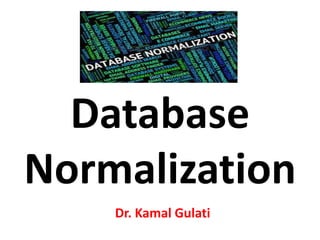













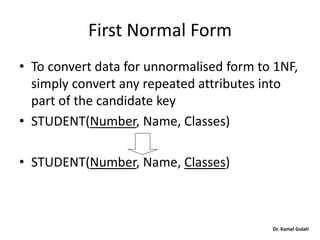



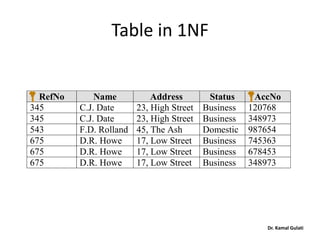

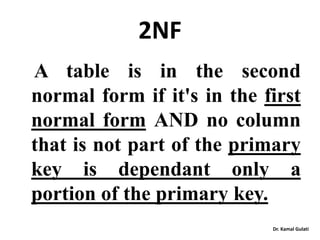

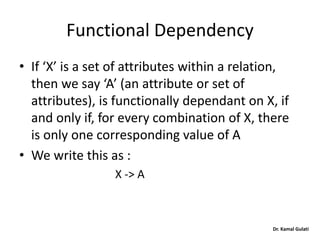
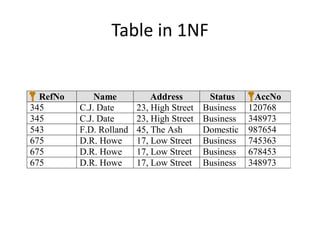





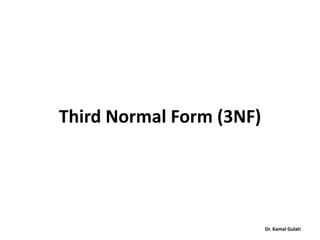


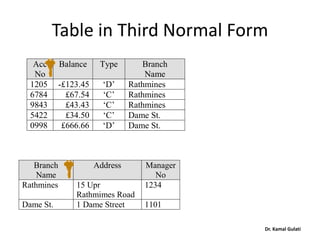




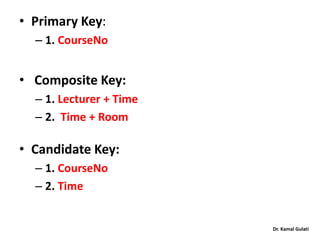
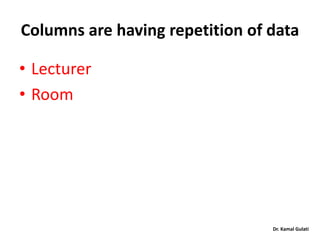















![Dr. Kamal Gulati
Dr. Kamal Gulati
Associate Professor |
University Quality Support Head
Mentoring Programme Coordinator &
Exam Superintendent |
[Ph. D., M.Sc. (Computer Science), M.C.A., M.B.A]
Professional Certifications:
• Certified Microsoft Innovative Educator
• Data Science 101 Certification from Big Data University
• R Language 101 Certification from Big Data University
• SQL Certification from SOLOLEARN.com
• Certified IBM Big Data 101 from Big Data University
• R Program & Python Certified from DataCamp
• Wiley Certified Big Data Analyst [WCBDA]
• Certification on DBMS from IIT Mumbai
• Certified Cisco Certified Network Associate [CCNA]
• Certified Microsoft Certified Professional [MCP]
• Certified Brainbench in (MS Access, MS Project, MySQL 5.7 Administration, Computer
Fundamentals, Advanced Ms. Excel & Windows OS)
• Real-time Advertising Fundamentals Certified from RTA Academy](https://image.slidesharecdn.com/databasenormalizationdr-171001104547/85/Database-Normalization-by-Dr-Kamal-Gulati-55-320.jpg)




